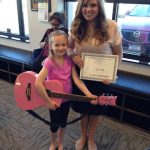Whether it’s Gene Kelly tap dancing in “Singing in the Rain” or Idina Menzel belting “Defying Gravity”, the power of capturing music, acting and dancing. It’s the mask of the Phantom in “Phantom of the Opera”. It’s Fontaine’s desperation and heartbreak in “Les Miserables”. It’s the innovative raps in Lin-Manuel Miranda’s “Hamilton”. There is so much the art of Musical Theatre has to offer, but first it starts with a story.
Musical Theatre is dialogue, music, acting, and dance. One of our teachers, Lynelle, says that Musical Theatre “allows a story to come to life in a new way that’s different from reading a book or watching a movie,”. She adds that, “having the characters telling their story from the stage in front of you is a one of a kind experience for both the performer and the viewer,”.
Musicals are performed everywhere around the world. Broadway in New York City is a stage many aspire to, yet sometimes the most intimate of venues can be the most powerful platforms for a show. Musicals were also an awesome way to have a social platform and discuss local issues. “Show Boat” and “South Pacific” were musical that discussed civil rights, as well as encouraged unity amongst all races. At the end of the Golden Age, “Fiddler on the Roof” wrestled with Jewish struggles and issues. Tolerance has been a recurring theme throughout the decades. People want harmony within a nation, and musicals are an excellent, fresh way to present different perspectives.
There are four different signing genres in Musical Theatre. First, there is Legit. This is traditional, classical singing with consistent vibrato, proper diction, and a balanced tone quality. Many musicals that cater to the Legit singing are from the Golden Age. Notable Legit singers include Julie Andrews, Audra McDonald, and Alfred Drake.
The next type of musical theatre singing is Traditional or Belt singing. This type of singing grew out of Tin Pan Alley. Typically singers use percussive diction, bright, speech-based, straight-tone sound. A well-known show that uses this style is “Cabernet,”.
Another style is Contemporary which sounds similar to Traditional but has heavy pop/rock influences. As well as being bright and speech-based, it is also normally placed in a higher vocal register. Though it is close to pop/rock songs, it still has clearer diction than a radio hit. “Wicked” and “Thoroughly Modern Millie” are two shows that use Contemporary singing.
Similar to Contemporary is the final musical theatre singing style called Pop/Rock. These songs feel current and relevant to music today. Men and women often sing in the same vocal range. There is often a heavy reliance on the instruments, similar to a pop/rock song. Aaron Tveit is a Pop/Rock musical theatre singing. “Rent”, “Spring Awakening”, and “Once” show good examples of songs that must be sung in this style.
At Omaha School of Music and Dance, kids have a phenomenal time honing in there dancing, singing, and stage presence with our teachers. Call us at 402-515-9639 or register online to join our fun Musical Theatre group class.



